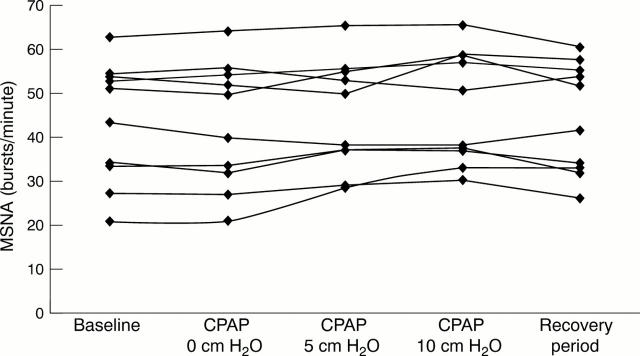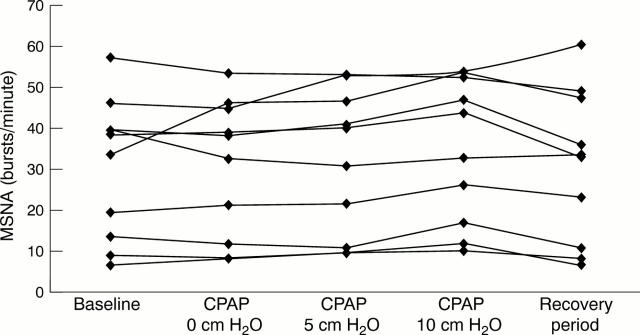Abstract
OBJECTIVE—To test the hypothesis that the short term application of continuous positive airways pressure (CPAP) increases muscle sympathetic nerve activity in patients with congestive heart failure. SETTING—University hospital and tertiary referral centre. PATIENTS—10 patients with congestive heart failure (New York Heart Association functional class III; mean (SEM) left ventricular ejection fraction 22 (1)%) and 10 healthy subjects matched for age, sex, and weight. MAIN OUTCOME MEASUREMENTS—Muscle sympathetic nerve activity, assessed by microneurography of the peroneal nerve, blood pressure, heart rate, minute ventilation, transcutaneous oxygen saturation, and end tidal PCO2 were measured during normal breathing, mask breathing, and CPAP at 5 and 10 cm H2O. RESULTS—CPAP induced an increase in muscle sympathetic nerve activity and blood pressure in both the patients and the control subjects. In the patients, sympathetic nerve activity increased from 43 (14) bursts/min during mask breathing to 47 (13) bursts/min at CPAP 10 cm H20 (p = 0.03); mean blood pressure increased from 80 (3) mm Hg to 86 (4) mm Hg (p < 0.001). Oxygen saturation improved during CPAP in the patients, from 95.7 (0.6)% to 96.6 (0.7)% (p = 0.004) and remained stable in the control group. There was no effect of CPAP on minute ventilation or heart rate. CONCLUSIONS—In patients with congestive heart failure, short term CPAP elicits sympathetic activation, probably because of unloading of the aortic or cardiopulmonary baroreceptors. Keywords: heart failure; sympathetic activation; continuous positive airways pressure
Full Text
The Full Text of this article is available as a PDF (127.4 KB).
Figure 1 .
Individual changes of muscle sympathetic nerve activity (MSNA) at baseline, during mask breathing (CPAP 0 cm H2O), during CPAP 5 and 10 cm H2O, and during the recovery period in the patients.
Figure 2 .
Individual changes of muscle sympathetic nerve activity (MSNA) at baseline, during mask breathing (CPAP 0 cm H2O), during CPAP 5 and 10 cm H2O, and during the recovery period in the control subjects.
Selected References
These references are in PubMed. This may not be the complete list of references from this article.
- Andreas S., Clemens C., Sandholzer H., Figulla H. R., Kreuzer H. Improvement of exercise capacity with treatment of Cheyne-Stokes respiration in patients with congestive heart failure. J Am Coll Cardiol. 1996 May;27(6):1486–1490. doi: 10.1016/0735-1097(96)00024-1. [DOI] [PubMed] [Google Scholar]
- Baratz D. M., Westbrook P. R., Shah P. K., Mohsenifar Z. Effect of nasal continuous positive airway pressure on cardiac output and oxygen delivery in patients with congestive heart failure. Chest. 1992 Nov;102(5):1397–1401. doi: 10.1378/chest.102.5.1397. [DOI] [PubMed] [Google Scholar]
- Bersten A. D., Holt A. W., Vedig A. E., Skowronski G. A., Baggoley C. J. Treatment of severe cardiogenic pulmonary edema with continuous positive airway pressure delivered by face mask. N Engl J Med. 1991 Dec 26;325(26):1825–1830. doi: 10.1056/NEJM199112263252601. [DOI] [PubMed] [Google Scholar]
- Bradley T. D., Holloway R. M., McLaughlin P. R., Ross B. L., Walters J., Liu P. P. Cardiac output response to continuous positive airway pressure in congestive heart failure. Am Rev Respir Dis. 1992 Feb;145(2 Pt 1):377–382. doi: 10.1164/ajrccm/145.2_Pt_1.377. [DOI] [PubMed] [Google Scholar]
- Buckle P., Millar T., Kryger M. The effect of short-term nasal CPAP on Cheyne-Stokes respiration in congestive heart failure. Chest. 1992 Jul;102(1):31–35. doi: 10.1378/chest.102.1.31. [DOI] [PubMed] [Google Scholar]
- Butler G. C., Naughton M. T., Rahman M. A., Bradley T. D., Floras J. S. Continuous positive airway pressure increases heart rate variability in congestive heart failure. J Am Coll Cardiol. 1995 Mar 1;25(3):672–679. doi: 10.1016/0735-1097(94)00427-R. [DOI] [PubMed] [Google Scholar]
- Carry P. Y., Baconnier P., Eberhard A., Cotte P., Benchetrit G. Evaluation of respiratory inductive plethysmography: accuracy for analysis of respiratory waveforms. Chest. 1997 Apr;111(4):910–915. doi: 10.1378/chest.111.4.910. [DOI] [PubMed] [Google Scholar]
- Cummin A. R., Alison J., Jacobi M. S., Iyawe V. I., Saunders K. B. Ventilatory sensitivity to inhaled carbon dioxide around the control point during exercise. Clin Sci (Lond) 1986 Jul;71(1):17–22. doi: 10.1042/cs0710017. [DOI] [PubMed] [Google Scholar]
- Davies R. J., Harrington K. J., Ormerod O. J., Stradling J. R. Nasal continuous positive airway pressure in chronic heart failure with sleep-disordered breathing. Am Rev Respir Dis. 1993 Mar;147(3):630–634. doi: 10.1164/ajrccm/147.3.630. [DOI] [PubMed] [Google Scholar]
- De Hoyos A., Liu P. P., Benard D. C., Bradley T. D. Haemodynamic effects of continuous positive airway pressure in humans with normal and impaired left ventricular function. Clin Sci (Lond) 1995 Feb;88(2):173–178. doi: 10.1042/cs0880173. [DOI] [PubMed] [Google Scholar]
- Delius W., Hagbarth K. E., Hongell A., Wallin B. G. General characteristics of sympathetic activity in human muscle nerves. Acta Physiol Scand. 1972 Jan;84(1):65–81. doi: 10.1111/j.1748-1716.1972.tb05158.x. [DOI] [PubMed] [Google Scholar]
- Ferguson D. W., Berg W. J., Sanders J. S. Clinical and hemodynamic correlates of sympathetic nerve activity in normal humans and patients with heart failure: evidence from direct microneurographic recordings. J Am Coll Cardiol. 1990 Nov;16(5):1125–1134. doi: 10.1016/0735-1097(90)90544-y. [DOI] [PubMed] [Google Scholar]
- Fewell J. E., Abendschein D. R., Carlson C. J., Rapaport E., Murray J. F. Mechanism of decreased right and left ventricular end-diastolic volumes during continuous positive-pressure ventilation in dogs. Circ Res. 1980 Sep;47(3):467–472. doi: 10.1161/01.res.47.3.467. [DOI] [PubMed] [Google Scholar]
- Haque W. A., Boehmer J., Clemson B. S., Leuenberger U. A., Silber D. H., Sinoway L. I. Hemodynamic effects of supplemental oxygen administration in congestive heart failure. J Am Coll Cardiol. 1996 Feb;27(2):353–357. doi: 10.1016/0735-1097(95)00474-2. [DOI] [PubMed] [Google Scholar]
- Lanfranchi P. A., Braghiroli A., Bosimini E., Mazzuero G., Colombo R., Donner C. F., Giannuzzi P. Prognostic value of nocturnal Cheyne-Stokes respiration in chronic heart failure. Circulation. 1999 Mar 23;99(11):1435–1440. doi: 10.1161/01.cir.99.11.1435. [DOI] [PubMed] [Google Scholar]
- Leech J. A., Ascah K. J. Hemodynamic effects of nasal CPAP examined by Doppler echocardiography. Chest. 1991 Feb;99(2):323–326. doi: 10.1378/chest.99.2.323. [DOI] [PubMed] [Google Scholar]
- Leimbach W. N., Jr, Wallin B. G., Victor R. G., Aylward P. E., Sundlöf G., Mark A. L. Direct evidence from intraneural recordings for increased central sympathetic outflow in patients with heart failure. Circulation. 1986 May;73(5):913–919. doi: 10.1161/01.cir.73.5.913. [DOI] [PubMed] [Google Scholar]
- Lenique F., Habis M., Lofaso F., Dubois-Randé J. L., Harf A., Brochard L. Ventilatory and hemodynamic effects of continuous positive airway pressure in left heart failure. Am J Respir Crit Care Med. 1997 Feb;155(2):500–505. doi: 10.1164/ajrccm.155.2.9032185. [DOI] [PubMed] [Google Scholar]
- Liston R., Deegan P. C., McCreery C., Costello R., Maurer B., McNicholas W. T. Haemodynamic effects of nasal continuous positive airway pressure in severe congestive heart failure. Eur Respir J. 1995 Mar;8(3):430–435. doi: 10.1183/09031936.95.08030430. [DOI] [PubMed] [Google Scholar]
- Mitchell J. H., Victor R. G. Neural control of the cardiovascular system: insights from muscle sympathetic nerve recordings in humans. Med Sci Sports Exerc. 1996 Oct;28(10 Suppl):S60–S69. doi: 10.1097/00005768-199610000-00036. [DOI] [PubMed] [Google Scholar]
- Montner P. K., Greene E. R., Murata G. H., Stark D. M., Timms M., Chick T. W. Hemodynamic effects of nasal and face mask continuous positive airway pressure. Am J Respir Crit Care Med. 1994 Jun;149(6):1614–1618. doi: 10.1164/ajrccm.149.6.8004320. [DOI] [PubMed] [Google Scholar]
- Naughton M. T., Floras J. S., Rahman M. A., Jamal M., Bradley T. D. Respiratory correlates of muscle sympathetic nerve activity in heart failure. Clin Sci (Lond) 1998 Sep;95(3):277–285. [PubMed] [Google Scholar]
- Naughton M. T., Liu P. P., Bernard D. C., Goldstein R. S., Bradley T. D. Treatment of congestive heart failure and Cheyne-Stokes respiration during sleep by continuous positive airway pressure. Am J Respir Crit Care Med. 1995 Jan;151(1):92–97. doi: 10.1164/ajrccm.151.1.7812579. [DOI] [PubMed] [Google Scholar]
- Naughton M. T., Rahman M. A., Hara K., Floras J. S., Bradley T. D. Effect of continuous positive airway pressure on intrathoracic and left ventricular transmural pressures in patients with congestive heart failure. Circulation. 1995 Mar 15;91(6):1725–1731. doi: 10.1161/01.cir.91.6.1725. [DOI] [PubMed] [Google Scholar]
- Nishian K., Kawashima S., Iwasaki T. Paradoxical forearm vasodilatation and haemodynamic improvement during cardiopulmonary baroreceptor unloading in patients with congestive heart failure. Clin Sci (Lond) 1993 Mar;84(3):271–280. doi: 10.1042/cs0840271. [DOI] [PubMed] [Google Scholar]
- Qvist J., Pontoppidan H., Wilson R. S., Lowenstein E., Laver M. B. Hemodynamic responses to mechanical ventilation with PEEP: the effect of hypervolemia. Anesthesiology. 1975 Jan;42(1):45–55. doi: 10.1097/00000542-197501000-00009. [DOI] [PubMed] [Google Scholar]
- Sanders J. S., Ferguson D. W., Mark A. L. Arterial baroreflex control of sympathetic nerve activity during elevation of blood pressure in normal man: dominance of aortic baroreflexes. Circulation. 1988 Feb;77(2):279–288. doi: 10.1161/01.cir.77.2.279. [DOI] [PubMed] [Google Scholar]
- Scharf S. M., Chen L., Slamowitz D., Rao P. S. Effects of continuous positive airway pressure on cardiac output and plasma norepinephrine in sedated pigs. J Crit Care. 1996 Jun;11(2):57–64. doi: 10.1016/s0883-9441(96)90021-0. [DOI] [PubMed] [Google Scholar]
- Seals D. R., Johnson D. G., Fregosi R. F. Hyperoxia lowers sympathetic activity at rest but not during exercise in humans. Am J Physiol. 1991 May;260(5 Pt 2):R873–R878. doi: 10.1152/ajpregu.1991.260.5.R873. [DOI] [PubMed] [Google Scholar]
- Seals D. R., Suwarno N. O., Dempsey J. A. Influence of lung volume on sympathetic nerve discharge in normal humans. Circ Res. 1990 Jul;67(1):130–141. doi: 10.1161/01.res.67.1.130. [DOI] [PubMed] [Google Scholar]
- Selldén H., Sjövall H., Wallin B. G., Häggendal J., Ricksten S. E. Changes in muscle sympathetic nerve activity, venous plasma catecholamines, and calf vascular resistance during mechanical ventilation with PEEP in humans. Anesthesiology. 1989 Feb;70(2):243–250. doi: 10.1097/00000542-198902000-00011. [DOI] [PubMed] [Google Scholar]
- Somers V. K., Mark A. L., Zavala D. C., Abboud F. M. Contrasting effects of hypoxia and hypercapnia on ventilation and sympathetic activity in humans. J Appl Physiol (1985) 1989 Nov;67(5):2101–2106. doi: 10.1152/jappl.1989.67.5.2101. [DOI] [PubMed] [Google Scholar]
- Sundlöf G., Wallin B. G. Effect of lower body negative pressure on human muscle nerve sympathetic activity. J Physiol. 1978 May;278:525–532. doi: 10.1113/jphysiol.1978.sp012322. [DOI] [PMC free article] [PubMed] [Google Scholar]
- Tanaka S., Sagawa S., Miki K., Claybaugh J. R., Shiraki K. Changes in muscle sympathetic nerve activity and renal function during positive-pressure breathing in humans. Am J Physiol. 1994 Apr;266(4 Pt 2):R1220–R1228. doi: 10.1152/ajpregu.1994.266.4.R1220. [DOI] [PubMed] [Google Scholar]
- Vallbo A. B., Hagbarth K. E., Torebjörk H. E., Wallin B. G. Somatosensory, proprioceptive, and sympathetic activity in human peripheral nerves. Physiol Rev. 1979 Oct;59(4):919–957. doi: 10.1152/physrev.1979.59.4.919. [DOI] [PubMed] [Google Scholar]




